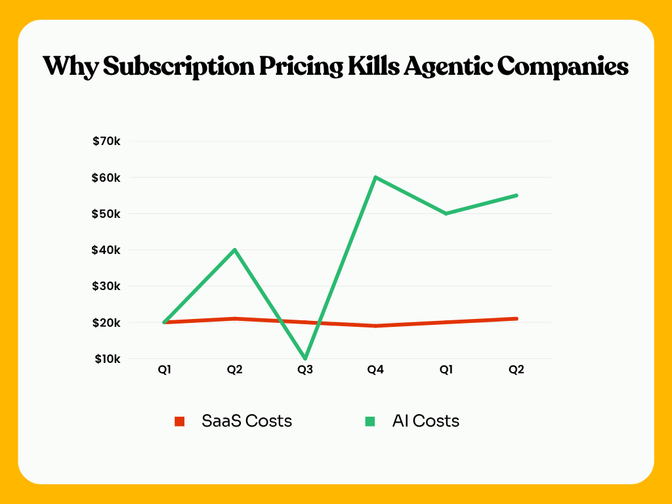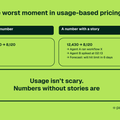Insights straight to your inbox
Join 10,000+ subscribers getting the latest insights on AI monetization.


At Paid, we’ve spoken with more agentic AI founders than anyone else. They all think they’re the only ones secretly guessing at pricing.
Even the ones who don’t think they’re mimicking SaaS playbooks are often doing so by accident. And when we show them how their pricing kills Agentic Margin, the same explanation always comes up:
"My customers want predictable pricing. It needs to be the same every month."
That feels reasonable… until you ask:
“Why do customers want predictable pricing in the first place?”
In the SaaS era, pricing predictability made sense. Infrastructure costs were relatively fixed. Whether users logged in once a week or 100 times a day, the bill stayed steady. Predictability was easy to offer, and customers came to expect it.
Agentic AI doesn’t work like that. Every action your agent takes, every prompt, API call, speech synthesis, avatar render incurs variable cost. And those costs don’t scale linearly with usage. They spike with task complexity and change as user behavior evolves.
Unlike SaaS, usage can’t always be tied to a single user because in some cases, the agent is replacing the user.
Trying to force predictability in this model is like trying to sell Uber rides on a Netflix subscription. Netflix is a fixed fee because it’s a fixed cost. Charge someone $12/month for Uber and they’ll cost you $800 in driver payouts.
Whether or not we want to admit it, founders are all too happy to acquiesce simply because it’s easier. Measuring and tracking the costs associated with agentic work is difficult because the systems for tracking them haven’t caught up to demand - as Steve Jobs also found out when they were manufacturing the Apple II.
The tools needed to track and price agentic labor correctly are scarce. While your typical SaaS app consumes resources rather predictably (like monthly subscriptions), AI agents are more like having a consultant who might spend 10 minutes or 3 hours on the same task, depending on how the conversation unfolds.
And the length of the conversation matters too. The costs are all over the place: one simple customer support interaction might cost $0.02 with a cheap model, but if the agent gets confused and starts looping through different models, calling external APIs, and building up massive context windows, that same interaction could suddenly cost $0.50 (that’s 25x more, and that’s not a mistake).
If you consider how every AI provider prices differently (OpenAI's tokens aren't the same as Anthropic's, Google’s way of charging is even more confusing somehow), and you've got a real problem where you just need to guess because building proper usage tracking feels impossible.
Yes, there are tools that are emerging to track it (like LangSmith for deep workflow analysis or AICosts.ai for multi-provider visibility) but most companies are still flying blind.
So, agentic founders are falling back on what their SaaS predecessors did before them and pricing “the way we’ve always done it.”
Predictable losses are worse than unpredictable wins. No CFO is turning down 300% ROI because the invoice varied by 15%.
On the face of the business, subscription pricing devalues agentic work because it minimizes the results the agent produces.
On the backend, if your costs fluctuate but your revenue doesn’t, margin becomes a mystery.
It’s a lose-lose.
You burn your AMR (Agentic Margin Ratio) while positioning yourself as a commodity.
Agentic Margin ÷ Revenue Generated by Agent = Agentic Margin Ratio
You end up subsidizing power users and overcharging light ones.
You lose the ability to optimize because your pricing isn’t connected to what your agents actually do.
In trying to give customers peace of mind, you’ve sacrificed your own clarity and control. Your differentiation from your competitors evaporates and you have no moat.

Your customers don’t need the same invoice every month, but they do need protection from “fear of spikes.”
Candid conversations with agentic builders have helped us uncover viable solutions for pricing predictability - that don’t break the Agentic Margin.
1. Flat Fee + Outcome component
Some buyers want simplicity. Others want performance alignment. Give them both.
Offer two clear options:
2. Capped Outcome pricing
The biggest fear with variable pricing is runaway costs. Fix it with a cap (aka ceiling)!
Set your outcome based pricing with a monthly cap (e.g. 150% of flat rate equivalent). This gives you upside while giving customers a ceiling they can plan against.
Bonus: Use past customer data to simulate 12 months of invoices under each model. Share that with your customers to prove the value you generate.
3. Hybrid: Upfront Now, Success Later
For seasonal businesses, like education or hospitality, timing matters. Don’t force revenue when outcomes won’t happen.
Try this combo:
Or, build in credits: Let them “earn” outcomes in their slow season and “spend” them in their busy season.
Q: "What if our usage is seasonal?"
A: You put in some safeguards. Allow pauses, place a cap. Predictability doesn’t mean monthly uniformity.
Q: "Procurement won’t approve variable billing."
A: Frame variable elements as performance-based. Bundle them with a fixed platform fee. This isn’t too different from paying your sales people a commission.
Q: "We don’t have enough data to model this yet."
A: Yes so start now! Track usage at the task, workflow, and outcome level. The sooner you collect signals, the sooner you can price confidently.
Q: "What if usage grows way beyond what we modeled?"
A: Great. That means value is growing. This is an excellent signal, not something to be afraid of. This means you can offer a discount or renegotiate the contract.
Wherever you are on the pricing journey, fixed, hybrid, or outcome-based, Paid helps you:
We don’t force you into a pricing philosophy. We help you operationalize the one that matches how your agents work.
Predictability is a feature. Alignment is a strategy!
If you’re selling value, your pricing should prove it and Paid helps you get there.
Join 10,000+ subscribers getting the latest insights on AI monetization.



Price smarter. Protect margins. Grow revenue.